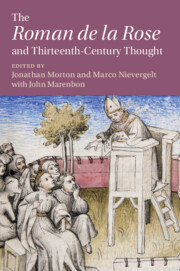Book contents
- The Roman de la Rose and Thirteenth-Century Thought
- Cambridge Studies in Medieval Literature
- The Roman de la Rose and Thirteenth-Century Thought
- Copyright page
- Contents
- Contributors
- Acknowledgements
- Note on Primary Texts
- Introduction
- Part I Epistemology and Language
- Chapter 1 Mechanisms of Belief
- Chapter 2 Visual Experiences and Allegorical Fiction
- Chapter 3 Imposition, Equivocation, and Intention
- Chapter 4 Sophisms and Sophistry in the Roman de la Rose
- Part II Natural Law, Politics, and Society
- Part III Unfinished Business
- Notes
- Bibliography
- Index
- Cambridge Studies in Medieval Literature
Chapter 4 - Sophisms and Sophistry in the Roman de la Rose
from Part I - Epistemology and Language
Published online by Cambridge University Press: 17 June 2020
- The Roman de la Rose and Thirteenth-Century Thought
- Cambridge Studies in Medieval Literature
- The Roman de la Rose and Thirteenth-Century Thought
- Copyright page
- Contents
- Contributors
- Acknowledgements
- Note on Primary Texts
- Introduction
- Part I Epistemology and Language
- Chapter 1 Mechanisms of Belief
- Chapter 2 Visual Experiences and Allegorical Fiction
- Chapter 3 Imposition, Equivocation, and Intention
- Chapter 4 Sophisms and Sophistry in the Roman de la Rose
- Part II Natural Law, Politics, and Society
- Part III Unfinished Business
- Notes
- Bibliography
- Index
- Cambridge Studies in Medieval Literature
Summary
This chapter considers how it might make sense to think of the allegorical fiction as philosophical. The unsettling figure at the heart of the Roman de la Rose Faux Semblant is a walking sophism, embodying the paradox sometimes known as the Cretan Liar’s paradox: he tells us that he is lying and that nothing that he says can be trusted. In a sense he represents an extreme case of the problem of all literary endeavours that claim to offer truth through falsehood. In his sermon on hypocrisy, Faux Sembant explicitly names Aristotle’s De sophisticis elenchis, implying a connection between the Rose’s hermeneutic problems and those considered as part of dialectical training in medieval schools. This chapter reads the Rose against the tradition of the De sophisticis and sophismata-literature to show the poem itself as offering an education in sophistry, taken in a broader sense than its use in language arts. Sophism and sophistry are used figuratively throughout the Rose to refer to hypocrisy and falseness of all kinds, including literary falseness. Rooted in the intellectual culture of the university, the Rose considers the value of lying and the benefits of reading a work that rarely means what it says.
Keywords
- Type
- Chapter
- Information
- The ‘Roman de la Rose' and Thirteenth-Century Thought , pp. 90 - 108Publisher: Cambridge University PressPrint publication year: 2020

